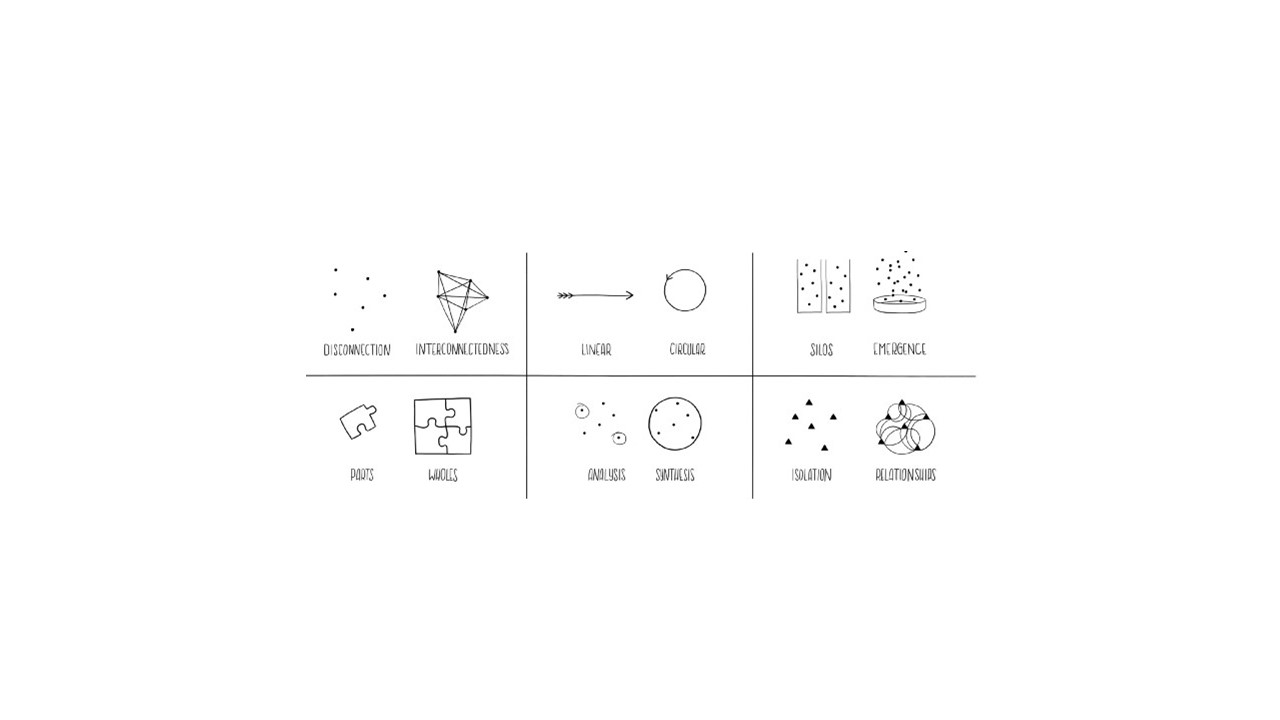
The famed statistician and quality consultant, Dr. W. Edwards Deming, defined a system as “…. a network of interdependent components that work together to try to accomplish the aim of the system. A system must have an aim. Without the aim, there is no system.”
Systems thinking is based on the concept that it is better to view all the components as a whole rather than as individual components, while focusing on the interrelationship of the individual components.
Overview: What is systems thinking?
Systems thinking is based upon the concept that all systems are composed of interconnected parts. These connections and interrelationships cause behavior of one part to impact another. All parts are connected.
Key elements of a system are:
- Input, Processing, and Output
- Control
- Feedback:
- Boundaries
- Environment
Problems that are ideal for a systems thinking intervention have the following characteristics:
- The issue is important.
- The problem is chronic and ongoing and not just a one-time event.
- The problem is familiar and has a known history.
- Previous attempts to solve the problem have failed.
Key concepts of systems thinking:
- Interconnectedness – everything is connected
- Synthesis – Synthesis is about understanding the whole and the parts at the same time, along with the relationships and the connections that make up the whole. This is different from analysis which is the dissection of complexity into manageable individual components.
- Emergence – Emergence is the outcome of the synergies and interrelationships of the parts.
- Feedback Loops – Since everything is interconnected in systems thinking, there are constant feedback loops and flows between the elements of the system.
The graph below illustrates the difference between systems thinking and non-systems thinking concepts.

Difference in concepts between systems and non systems thinking
Tools of systems thinking used to collect, analyze, synthesize, and develop system insights are:
- ladder of inference
- behavior-over-time graph
- connection circle
- stock-flow map
- iceberg visual
- causal loop diagram.
3 benefits of systems thinking
As the world becomes more complex, systems thinking will provide you the following benefits:
- See the bigger picture
Systems thinking allows you to view things from the 30,000-foot perspective rather than from ground level.
- Greater clarity
By zooming out and viewing the wider process, you can see the interrelationships and interactions between your system elements.
- Understand and fix the “problems that never seem to go away”
Most problems are caused by the interaction of things rather than only by the individual element. Systems thinking will help you better understand these interactions so you can solve the more complex and chronic problems you always seem to have.
Why is systems thinking important to understand?
In a world where interconnectedness and complexity exists understanding systems thinking offers you a disciplined approach to find innovative solutions to problems.
Encourage a big picture perspective
By understanding the system’s interconnected parts, their historical evolution and their relationships with each other, systems thinkers can look for other optional ways of achieving system improvement
See problems as opportunities
Without a way to see problems in the context of a complex, interconnected whole system, solving problems using linear thinking risks making your problem more complex.
Understand and prepare for rapid change
Systems thinking offers a way to better predict future outcomes—based not on past events, but on a more insightful understanding of the surrounding environment and its elements.
An industry example of systems thinking
One of the classic examples showing the contrast between systems and non-systems thinking relates to a problem at the Washington Monument in Washington, D.C. The problem was the surface of the monument was disintegrating. A team was formed to analyze the problem. They initially used the 5 Why technique, which is a version of the cause and effect technique.
Every time they thought they solved the problem; they created a new one. Eventually they stood back and viewed the problem through the lens of systems thinking rather than individual events. The solution was quick and inexpensive. Here was the thought process:
- Why is the Monument disintegrating? – Because of the use of harsh chemicals.
- Why are harsh chemicals being used? – To clean pigeon poop – solution is to change chemicals.
- Why are there so many pigeons? – They eat spiders and there are a lot of spiders at the monument – solution is to put up insect netting.
- Why so many spiders? – They eat gnats and there are lots of gnats at the monument.
- Why so many gnats? – They are attracted to the light at dusk.
Solution: Turn on the lights 30 minutes later.
3 best practices when thinking about systems thinking
Here are a few tips for effectively using systems thinking.
- Ask different questions
Try to ask questions about underlying structural relationships or patterns of behavior exhibited over time. Focus on potential delays, balancing or reinforcing processes, and unintended consequences. Use circular rather than linear thinking.
- Search out and use feedback loops
Information gleaned from your system feedback loops will give you insight into potential relationships and interactions between process elements and the subsequent impacts.
- Think about system boundaries
Understand what elements of your process are part of the system and what is in the surrounding environment that may change and affect the state of the system. To draw this boundary you need to know your scope of action, what you can alter and what lies beyond your ability to directly change.
Frequently Asked Questions (FAQ) about systems thinking
What is the opposite of systems thinking?
Systems thinking is circular in nature while non-system thinking is linear. System thinking looks at the whole and the relationship of the parts. Non-system linear thinking looks at the individual components of the process.
What is systems thinking?
Systems thinking is a management approach that views a system as a set of linkages and interactions between the components which make up the entire defined system.
What are the basic concepts of systems thinking?
They are:
- Interconnectedness – Everything is connected.
- Synthesis – Synthesis is about understanding the whole and the parts at the same time, along with the relationships and the connections that make up the whole. This is different from analysis which is the dissection of complexity into manageable individual components.
- Emergence – Emergence is the outcome of the synergies and interrelationships of the parts.
- Feedback Loops – Since everything is interconnected in systems thinking, there are constant feedback loops and flows between the elements of the system.
- Causality – In systems thinking, causality is about being able to understand the way the parts of the system influence each other.
- Systems Mapping – Here you Identify and map the elements within a system to understand how they interconnect, relate and act in the overall system.
Summary
Systems thinking is based on the concept that the parts of a system or process are all connected and the relationship between these parts drives the behavior and outcomes of the system. By seeking to understand the connectedness of all the components you can understand how the process works and can gain insights to allow for system improvements.